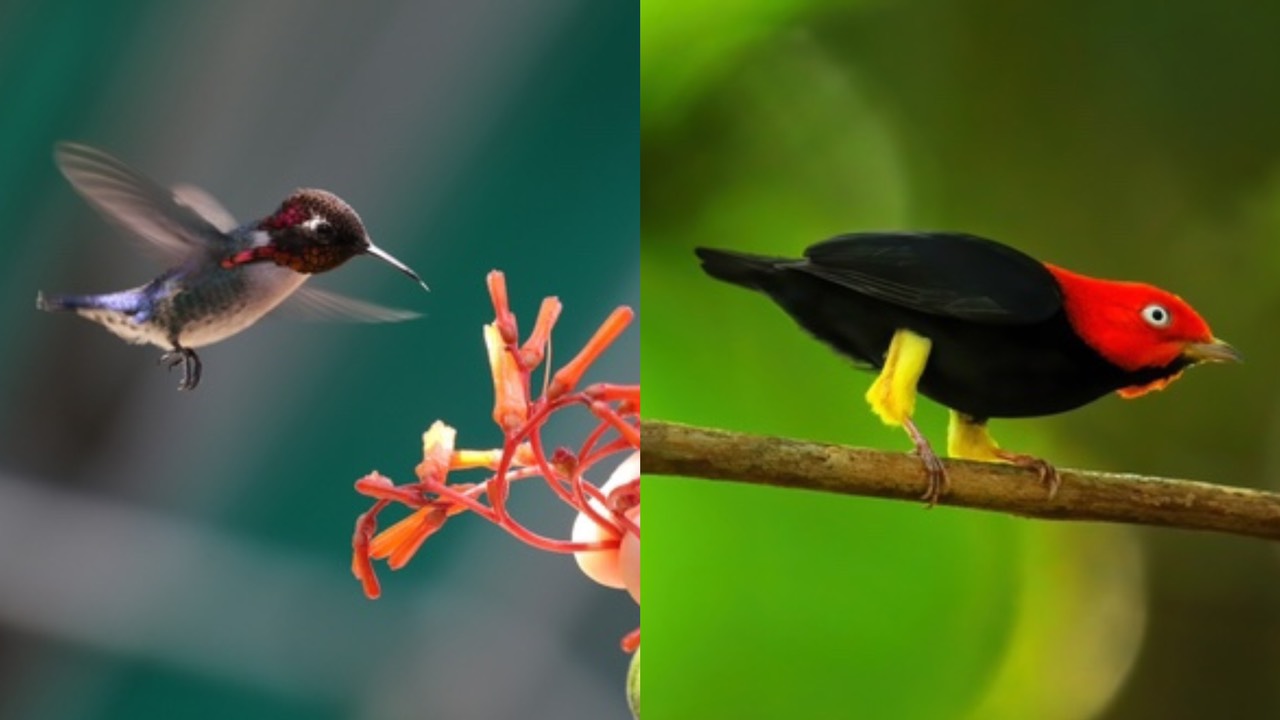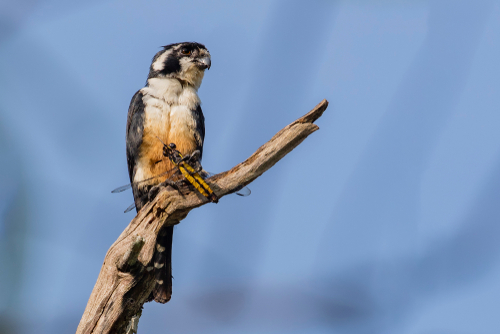
When most folks think of amazing birds, their minds might go to the largest (the ostrich), the fastest (peregrine falcon), or maybe even the funkiest dance moves (the birds of paradise). But with over 10,000 bird species in the world, there are plenty of species of bird that you may have never heard of before. While we can’t review all the species here, we’ve included a handful of interesting birds along with some fascinating facts about why they stand out from their feathered friends.

Most people know that birds can sing… or at least whistle, croak, and chirp. Unless evolutionarily determined to be sneaky like a blue grouse, birds are very conspicuous animals. Bright colors and loud songs make them easy to spot. While many Aves species have distinct vocalizations, one group of birds has developed a surprising strategy to make a sound. By vibrating feathers on their wings and clacking wings together, manakins (Pipra spp.) create the buzzing and humming sounds, reminiscent of violins. Combined with clicks, chirps, and stellar dance moves, a single bird provides the entertainment of both a symphony orchestra and ballet.
Rainforests of Central and South America
Being able to snap their wings fast and hard enough to create sound takes quite a bit of force. Because of this, manakins have solid wing bones (opposed to normal bird bones with large air pockets) to stand up to their vigorous dancing. Given the extra weight, manakins are quite the clumsy fliers.

From an aesthetic perspective, bower birds themselves are unremarkable. With slightly iridescent feathers and the posture of a large sparrow, you might not think twice about seeing these birds outside of the breeding season. But their modest appearance does nothing to reveal their creative prowess. As a part of their mating ritual, male bower birds build delicately curated sculptures to attract a female. Using mostly plant matter to create a foundation, bowerbirds then decorate their creations with the intentionality of a fashion designer. Often sticking religiously to a color scheme, the bower birds are incredibly picky about their placements, constantly rearranging and straightening their bower.
Australia and New Guinea
Bower birds find all sorts of treasures to decorate their bowers including flowers, feathers, and berries. However, they are not immune to human influence. Today, the birds collect pen caps, rubber, fabric and paper scraps, and bottle tops to add to their bowers.

While you likely knew about the largest bird in the world before reading this article, you probably aren’t as familiar with the smallest. Weighing less than two paperclips, the bee hummingbird (Mellisuga helenae) proudly takes this superlative. Though small, the bee hummingbird is far from powerless. In fact, these wee, buzzy birds consume half their body weight in food every day, pollinating upwards of 1,500 flowers each day. All that work takes some energy. Relative to their size, bee hummingbirds burn the daily energy equivalent to a human running ten marathons!
Cuba and surrounding islands
Being as small as a bee has some consequences. Many invertebrates like spiders, wasps, and praying mantids hunt and eat bee hummingbirds.

Featured on cereal boxes and dad jokes, everyone is familiar with the toucan. Large bill, lots of colors…you get the idea. But the toucan’s lesser-known cousin, the emerald toucanet (Aulacorhynchus prasinus), is the toucan in miniature. In contrast to the classic keel-billed toucan (Ramphastos sulfuratus) that measures about two feet long, the emerald toucanet is less than half of that from beak to tail tip! If that level of cuteness doesn’t trigger a release of oxytocin and dopamine to your brain, I’d be shocked (and direct you to some pictures of baby penguins). With iridescent green feathers framed by a blue throat and orange rump, the emerald toucanet is a diminutive rainbow sensation!
Central and South America
During their mating ritual, toucanets gather fruit in their disproportionately large bills and start a game of toss between the male and female!

Fuzzy, funky, and flightless, kiwi birds make an obvious addition to this list. Not being able to fly defines their entire existence. However, on the plus side, they’ve developed strong legs and feet to dig their burrows and forage for food. Because they are not needed for aerodynamics, their feathers have evolved to provide cozy warmth, giving them a muppet-like appearance. On the other hand, being flightless has put them at huge risk. Because they have evolved without natural predators, they lack a sharp instinct to avoid danger. Poaching the birds for the feather trade and introducing predators has caused declines in their populations. As a result, the people of New Zealand have rallied together to protect the kiwi population!
New Zealand. Kiwi birds are endemic to the island chain, meaning they can be found nowhere else in the world.
All five species of kiwis have an extraordinary sense of smell. With nostrils at the tip of their beaks, they make up for their poor eyesight with a good sniffer!

“There once was a puffin, in the shape of a muffin…” starts the classic Florence Page Jaques poem. While puffins may look more like footballs than muffins, Jacques did get a few things correct. They do, indeed, “live on an island in the deep blue sea.” Puffins choose remote, treeless islands for their nesting colonies. She was also mostly correct with the “eat little fishes” line. While puffins will fill their bills with small fish, invertebrates make up a large proportion of their diets as well. As far as looks go, they appear clown-like with their bright orange bill and long white ear tufts. Additionally, tufted puffins live in colonies throughout the Pacific ocean.
Northern pacific coastlines, including Russia and North America
With short wings that evolved for swimming and diving, puffins work harder than the average bear (bird) to take flight. In fact, they flap their wings 400 times each minute, creeping up on hummingbird status. When nesting on cliffsides, they take advantage of the elevation to lift into the air, but when lifting off from the water, they must rely on their strong breast muscles to power them.

The ultimate punk rockers, woodpeckers take headbanging to a whole new level. Using their beaks to chip away cavities in tree trunks, woodpeckers create secure and cozy nesting habitats for their own families as well as many other bird species that like nesting in a tree hole without putting in the work to make it themselves (looking at you toucans and chickadees). The Magellanic woodpecker grows up to 18 inches long. Consequently, it is the largest species of woodpecker in South America. Flying underneath the open canopies of old-growth beech forests, this beautiful bird is reminiscent of dragons in folklore.
Southern Chile and Argentina
Why don’t woodpeckers get concussions? In contrast to the human head, their birdbrains have plenty of padding. Between a spongey texture to their bone and a tongue that wraps around their skull, they don’t lose too many brain cells while making their nests. (not that they had too many to start…)

No, we didn’t spell potato wrong. But a potato isn’t so far removed from the four species of potoo bird. With grey and brown mottled plumage and wildly dilating eyes, potoo birds look more like a potato with googly eyes than any other root vegetable. This nondescript appearance helps them stay camouflaged during the day. Being nocturnal, potoos spend the sunshine hours pretending to be a tree branch. But camouflage isn’t their only interesting superpower. Their beaks look quite petite when closed, they can open comically wide, giving them the nickname frogmouths. Though silly to the human eye, these beaks come in handy for plucking moths and other flying insects out of the air.
Tropical Central and South America
Potoo birds have quite an eerie call. On moonlit nights, a fading cascade of “BU-OHs” fills the dark. In the same order as the nightjars of North America, this sound could be likened to the call of the whippoorwill or chuck-will’s-widow.

Endemic to the Indonesian island of Sulawesi, the Red-knobbed hornbill (Aceros cassidix) makes a formidable site. Already, the bird has a bill with the width and length to rival the biggest toucan (never mind the tiny toucanet), but hornbills get their name from the large casque that sits atop the beak. The casque is more than just for looks. Hornbills are known for their incredibly loud vocalizations that can be heard from over a mile away. In fact, the extra weight of the casque provides extra resonance for their calls, like an amplifier! Additionally, hornbills are voracious frugivores, hornbills play an important role as seed dispersers in their ecosystems.
Indonesia
Because of their prized casques and feathers, hornbills of all species are targets of poachers.

If you haven’t yet been convinced that birds are modern-day dinosaurs, let me introduce you to the hoatzin. While every other bird’s forelimbs evolved into wings, the hoatzin is the only bird to have retained some characteristics of its pterodactyl ancestor. In fact, as juveniles, baby hoatzins have a set of claws on the ends of their wings! This strange feature helps the flightless babies to clamber around in the vegetation. Since these pheasant-looking birds live in flooded, swampy forests, retaining claws as juveniles makes the difference between drowning and surviving for the baby hoatzins. Though they lose their claws as they develop feathers, even adult hoatzins will use their wings to help balance through the brush.
Tropical South America
To digest all the plant matter they eat, bacteria in the hoatzin’s crop ferments the food matter. During this predigestion stage, similar to a cow’s and other ruminants, the bacteria creates a foul odor around the animal, giving the bird the nickname “stinkbird.”

While ravens (Corvus corax) seem like a strange bird to have on this list because of their popularity in lore and legend, we’ve included them because their remarkable intelligence is less canon. Along with many other members of the Corvidae family, ravens have demonstrated impressive cognitive skills. Often claimed to be more advanced than human toddlers, ravens have impressive memories for food caches, understand water displacement, and use tools to help them forage.
Wide distribution from arctic and temperate regions of North America and Eurasia to mountainous regions of South America and North Africa.
In addition to their own advanced communication system with over 30 vocalizations, ravens can imitate human speech like a parrot!

Another New Zealand bird at the whim of island biogeography, the kakapo rivals the kiwi bird as the silliest bird of the archipelago. A strange species of parrot, the ground-nesting kakapo can’t fly. Additionally, it forages at night and has a facial disc similar to an owl. Being flightless, the kakapo is the heaviest parrot, clocking in upwards of 13 pounds. However, the extra weight doesn’t stop them from waddling all over the forest. Using their beak and claws, they even climb trees to forage for all sorts of plant matter.
Endemic to New Zealand
When not threatened by predators or habitat loss, kakapos can live extraordinarily long lives between 60 and 90 years!

At only 5-6 inches long, the black-thighed falconet is the smallest bird of prey in the world. Commonly found along forest edges in its native range, this wee raptor also thrives in burn sites of recent forest fires. Known for their agile hunting skills, they can strike prey in midflight, then use their talons to rip the unfortunate animal apart. These tiny, wild birds are secondary-cavity nesters, and they seek out woodpecker excavations during the breeding season.
Southeast Asia
These tiny falcons eat a diet of mostly invertebrates but occasionally will prey on reptiles or even other bird species.

With an even bigger wingspan than the California condor, the wandering albatross spreads its feathers almost 12 feet across. This giant seabird puts its soaring abilities to good use. For example, they fly over 500 miles in a single day with just a few wing flaps.
Southern Oceans
Not only do albatross’ have an amazing wingspan, but they also have an amazingly long life. Living for 50-60 years, these impressive birds spend most of their lives in flight. Consequently, they only land to feed and breed.

Perhaps the strangest poultry bird in the world, the vulturine guinea fowl has ornate feathers typical of its family and a bald head like a vulture. They are omnivorous creatures that eat a mix of seeds, roots, and invertebrates, as well as small rodents and reptiles. With the largest body size of any guineafowl, the Vulturine stands around two feet tall.
East Africa
Though they prefer to fly into trees for their nightly roost, Vulturine guinea fowl spend most of their time on the ground and are excellent runners.
While there are plenty of stunningly beautiful and shocking strange-looking birds, more often it’s their fascinating behaviors that make birds such interesting animals. From flight patterns to feeding habits, birds have captured the attention of nature lovers around the globe. Next time you go out birdwatching, see what interesting birds you can spot even in your own backyard!
Check us out on EarthSnap, a free app brought to you by Eric Ralls and Earth.com.





